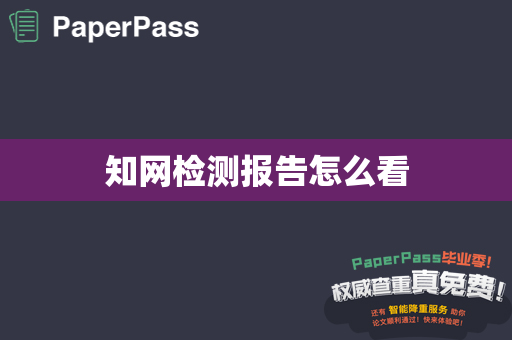知网检测报告怎么看
知网检测报告怎么看

If you have ever submitted an academic paper or a research work to CNKI (China National Knowledge Infrastructure), you would be familiar with the term "知网检测报告" (CNKI plagiarism detection report). The plagiarism detection report offered by CNKI is a comprehensive analysis of your submitted work and the results are expressed in a numerical value known as the "重复率" (similarity index). If you are wondering how to interpret the "知网检测报告" results or how to resolve any issues arising from high similarity index, this article has got you covered.
Understanding the CNKI Plagiarism Detection Report
The "知网检测报告" is an automated plagiarism detection system that can compare your submitted work against billions of resources available in the CNKI database. Once you submit your document, the system processes it, and generates a report that highlights all the sources with a considerable similarity index. There are four key components of the report that you should be aware of:
- Percentage Similarity
The percentage similarity of your document is the most important metric that you should be aware of. The similarity index displayed indicates the percentage of your written work that matches with other available sources. The lower the similarity score, the better your document is in terms of originality.
- Similarity Check Source
The similarity check source refers to the database containing the sources against which your submission is compared. CNKI relies on an extensive database that includes research papers, academic journals, and other academic works. The system compares your document with all available sources to generate an accurate report.
- Matched Sources
The matched sources section of the report contains a detailed list of all the sources that were found to have a considerable similarity index with your submitted work. You can view the details of each match and identify the specific areas where there is a similarity.
- Originality Index
The originality index displays the percentage of your work that is original and unique. The higher the originality index, the better your submission is in terms of authenticity.
Resolving CNKI Plagiarism Detection Report Issues
If your "知网检测报告" indicates a high similarity index, you can take the following steps to resolve the issue:
- Check for plagiarism instances
Scan through your paper and manually identify the areas that appear to be showcasing high similarity with other sources. Check if those areas contain any quotations, borrowed phrases, or sentences. If there are, use the appropriate citation and quotation style to avoid plagiarism.
- Utilize a paraphrasing tool
Utilize online paraphrasing tools that can help you to rephrase sentences and paragraphs in a manner that does not appear to be similar to other available sources.
- Generate original content
Generate original content for sections of your document that appear to be similar to existing resources. You can come up with new concepts, use examples, diagrams or charts, or add more analysis to differentiate your work from existing sources.
Frequently Asked Questions (FAQs)
- Can I use the CNKI plagiarism detection report to check for plagiarism in other plagiarism detection systems?
No, the CNKI plagiarism detection report is only applicable to the CNKI system. You cannot use the CNKI report to check the similarity index of a paper in other plagiarism detection systems.
- What is the similarity index threshold that can be considered safe in the CNKI plagiarism detection report?
There is no specific percentage similarity index threshold that has been set to be considered safe. Generally, a similarity index of less than 20% is considered acceptable, but this varies from one institution to another.
- How do I download the CNKI plagiarism detection report?
Once you login to your CNKI account, navigate to the plagiarism detection section and select the report that you need. Click on the download button, and the report will be saved in your device.
Conclusion
The CNKI plagiarism detection report offers a comprehensive analysis of your submitted work, indicating any instances of plagiarism, and offers an opportunity to improve your work's originality. Understanding how to read and interpret the report can help you make the necessary improvements to your work and ensure that it is 100% original. Keeping in mind the strategies mentioned above can help you to resolve any issues arising from high similarity index reported in the "知网检测报告."
paperpass问答网版权声明:以上内容作者已申请原创保护,未经允许不得转载,侵权必究!授权事宜、对本内容有异议或投诉,敬请联系网站管理员,我们将尽快回复您,谢谢合作!
